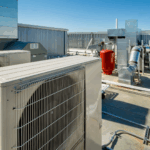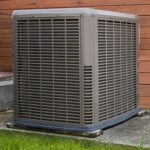As homeowners look for energy-efficient ways to heat and cool their spaces, ductless mini-split systems have become one of the most popular solutions in 2025. Known for their flexibility, quiet operation, and ability to provide zoned comfort, mini-splits are especially valuable in homes without existing ductwork.
On average, mini-split installation costs range from $2,500 to $8,000 in 2025. The final price depends on things like the size of the system, number of indoor units, brand, and labor costs. A small single-room system is usually on the lower end, while multi-zone systems for larger homes can be more expensive.
In this guide, we’ll explain the factors that affect mini-split installation costs, average prices, and how you can save money on your new system.

Understanding Mini Split Systems
A mini-split system is a heating and cooling solution that works without ductwork. Unlike traditional HVAC systems that rely on large networks of ducts to circulate air from a central unit, mini-splits deliver conditioned air directly into each room. By eliminating ducts, these systems avoid the energy losses that often occur due to leaks in older ducted setups, making them more efficient and reliable.
Main Components of a Mini Split System
- Outdoor Unit: This unit contains the compressor and condenser. It is responsible for releasing heat during cooling and pulling in outside air for heating when needed.
- Indoor Unit: Also called an air handler, this unit is mounted on the wall or ceiling of each room or zone. It distributes warm or cool air directly into the space and connects to the outdoor unit through small conduits containing the refrigerant line, power supply, and drain.
- Remote or Smart Control: Most mini-splits come with a handheld remote for adjusting temperature, fan speed, and operating modes. Many newer models also include Wi-Fi connectivity, allowing control via smartphone apps for added convenience.
Types of Mini Split Systems
- Single-Zone Systems: These connect one outdoor unit to one indoor unit, making them a cost-effective choice for single rooms, apartments, or home additions where independent climate control is needed.
- Multi-Zone Systems: These link one outdoor unit to multiple indoor units, allowing different areas or rooms to be heated or cooled separately. This setup is ideal for larger homes or commercial spaces where flexible temperature control across zones is important.
Average Mini-Split Installation Cost in 2025
According to 2025 HVAC cost data from contractors and industry sources, the average mini-split installation cost ranges between $2,500 to $8,000. Here’s a cost breakdown:
| System Type | Indoor Units (Zones) | Typical Cost Range | Average Installed Cost |
| Single-Zone Mini-Split | 1 | $3,200 – $6,000 | $4,500 |
| Dual-Zone Mini-Split | 2 | $4,500 – $8,500 | $6,000 |
| Multi-Zone (3–5 Units) | 3–5 | $5,500 – $12,500 | $8,000 |
| Large Multi-Zone (6+ Units) | 6+ | $10,000 – $15,000+ | $12,500+ |
A single-zone system is ideal for one room or a garage, while multi-zone systems are designed for entire homes, multi-level houses, or apartments. For more details on how these systems work, check out this U.S. Department of Energy guide on ductless mini-splits.
Key Factors That Affect Mini-Split Installation Cost
- Number of Zones: Single-zone systems are more affordable, while multi-zone setups increase cost.
- System Size: Smaller units (9,000–12,000 BTUs) cost $3,000–$4,500, while larger systems (30,000–36,000 BTUs) can reach $7,500–$12,000.
- Brand Choice: Premium brands like Mitsubishi or Daikin are pricier but come with longer warranties; budget brands like Pioneer or MrCool cost less.
- Installation Complexity: Extra work such as electrical upgrades, long refrigerant lines, or multi-story installs can add $500–$2,000.
- Labor Costs: Rates vary by region $70–$100 per hour in low-cost states and $100–$150+ in high-cost states.
Energy Efficiency & Quality of Ductless System
Another factor that impacts the cost of a mini-split system in 2025 is its energy efficiency and overall build quality.
- Energy Efficiency (SEER & HSPF Ratings): Mini-splits are rated by SEER (Seasonal Energy Efficiency Ratio) for cooling and HSPF (Heating Seasonal Performance Factor) for heating. Higher ratings mean lower utility bills but also a higher upfront price. For example, a 20+ SEER system may cost $500–$1,500 more than a standard 16 SEER unit but can save hundreds of dollars per year in energy costs.
- Inverter Technology: Most high-quality ductless systems now include inverter compressors, which adjust speed based on demand. This provides consistent comfort, quieter operation, and long-term savings.
- Build Quality & Features: Premium systems from brands like Mitsubishi and Daikin often include features like Wi-Fi controls, advanced air filtration, and extended warranties, which add to the price but improve comfort and durability. Budget systems may cost less upfront but usually have fewer smart features and shorter lifespans.
Ways to Save on Mini-Split Installation Costs
While mini-split systems can be a big investment, there are several smart ways to cut costs without sacrificing quality:
- Get Multiple Quotes: Compare at least 2–3 HVAC contractors to find the best balance of price and expertise.
- Choose the Right Size: Avoid oversizing. A properly sized system saves money upfront and reduces energy bills.
- Look for Rebates & Incentives: Many states, utility companies, and federal programs in 2025 offer rebates for high-efficiency ductless systems.
- Off-Season Installation: Scheduling your install in spring or fall can sometimes lower labor costs compared to peak summer or winter.
- DIY-Friendly Systems: Some brands like MrCool offer pre-charged, DIY-friendly kits that reduce labor costs (though professional installation is usually best for warranty coverage).
- Regular Maintenance: Keeping filters clean and scheduling tune-ups prevents costly breakdowns and extends system life.
Final Thoughts
A mini-split system is a great option in 2025 if you want comfort, energy savings, and flexible heating and cooling. The price can range from a few thousand dollars for a small setup to over $10,000 for larger homes, but the efficiency and year-round comfort often make it worth the investment.
By knowing what affects the cost, like system size, number of zones, brand, and labor—you can plan better and avoid surprises. Getting multiple quotes, looking for rebates, and choosing the right efficiency level can also help you save money.
If you’re ready to upgrade your home, a ductless mini-split could be the perfect way to stay comfortable all year long. Contact a trusted HVAC contractor near you today for a free quote and expert installation advice.
Frequently Asked Questions
1. How long does it typically take to install a mini split AC system?
Most mini-split installations take 4 to 8 hours for a single-zone system. Multi-zone systems or complex installs (such as multiple floors, long refrigerant lines, or electrical upgrades) may take 1–2 full days.
2. What are the energy efficiency benefits of mini split AC systems?
Mini-splits are highly efficient because they use inverter technology to adjust cooling and heating output as needed, instead of turning on and off like traditional systems. Many models in 2025 have 20+ SEER ratings, which can reduce energy bills by 30–40% compared to standard central AC.
3. Can mini split systems be used for both heating and cooling?
Yes, most ductless mini-split systems are heat pumps, meaning they provide both cooling in summer and heating in winter. This makes them a versatile, year-round comfort solution.
4. What maintenance does a mini split AC system require?
Mini-splits need basic maintenance to stay efficient. This includes cleaning or replacing air filters every 1–2 months, checking refrigerant levels, cleaning the outdoor condenser, and scheduling a professional tune-up once a year.
5. Are there any noise concerns with mini split AC systems?
Mini-split systems are known for being very quiet. Indoor units typically run at 20–30 decibels (quieter than a whisper), while outdoor units are much quieter than traditional central AC systems. This makes them ideal for bedrooms, offices, and living spaces.





Leave a Reply